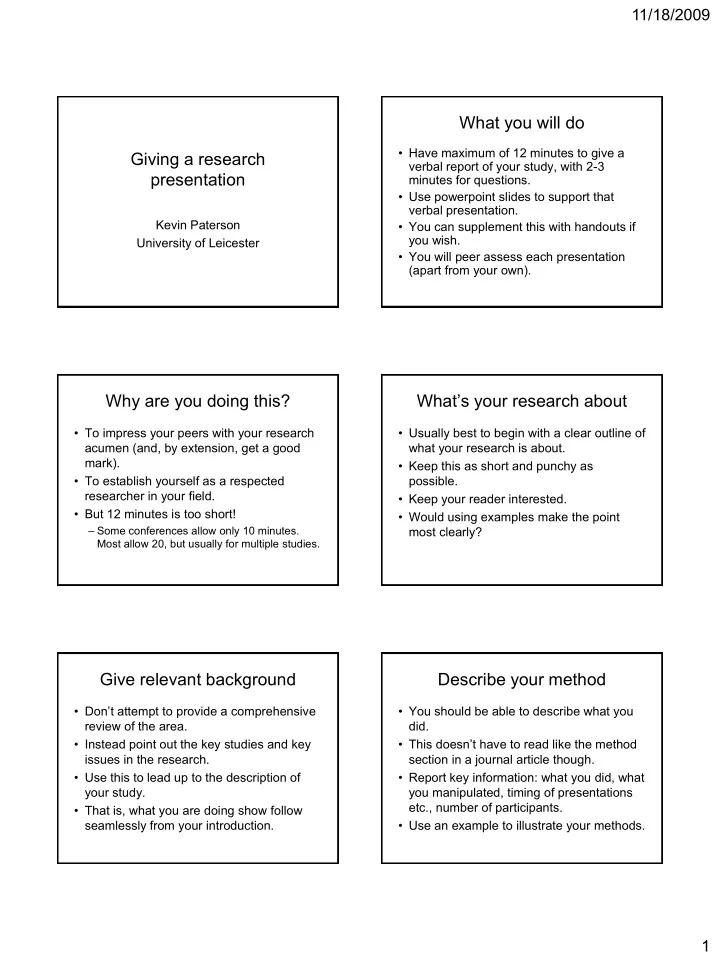

11/18/2009 What you will do • Have maximum of 12 minutes to give a Giving a research verbal report of your study, with 2-3 presentation minutes for questions. • Use powerpoint slides to support that verbal presentation. Kevin Paterson • You can supplement this with handouts if you wish. University of Leicester • You will peer assess each presentation (apart from your own). Why are you doing this? What’s your research about • To impress your peers with your research • Usually best to begin with a clear outline of acumen (and, by extension, get a good what your research is about. mark). • Keep this as short and punchy as • To establish yourself as a respected possible. researcher in your field. • Keep your reader interested. • But 12 minutes is too short! • Would using examples make the point – Some conferences allow only 10 minutes. most clearly? Most allow 20, but usually for multiple studies. Give relevant background Describe your method • Don’t attempt to provide a comprehensive • You should be able to describe what you review of the area. did. • Instead point out the key studies and key • This doesn’t have to read like the method issues in the research. section in a journal article though. • Use this to lead up to the description of • Report key information: what you did, what your study. you manipulated, timing of presentations etc., number of participants. • That is, what you are doing show follow seamlessly from your introduction. • Use an example to illustrate your methods. 1
11/18/2009 Describe your results Discuss your results • Summarise what you found. • Summarise your findings. • Use graphs if possible. • How do these findings fit with previous research? • Usually this will involve displaying mean and variance data (e.g., use confidence • Were there obvious problems with your intervals). study that affected your findings, or that merit further investigation? • Talk the reader through your graph, indicating what it shows, what each axis • What’s the next step? represents, what effects are visible. • Reach a clear conclusion. Answering questions Tips • Be polite and non-aggressive (even in face • Don’t try to write in full sentences. of criticism). • Use short, snappy, bullet points. • Try to answer questions, but it is fine to • Don’t include large chunks of text (except say you don’t understand a question, or if this is an example of your materials). that you don’t know an answer (unless, of • Don’t assume that readers either read or course, it is something you should have understand. known!). • Read over your points, and explain and elaborate those points. Tips Tips • Use examples wherever possible. • Keep your text visible. • These will clarify the points you are • Font size making. – Use point 18 as a minimum. – Point 24 or 28 is better. • In particular, use examples to illustrate the • Best also to use sans serif, e.g., Arial, Tahoma . methods you used. Avoid heavy serif fonts, e.g., Baskerville old face! • Use graphs to illustrate results. New century schoolbook. • Adjust text size on graphs (especially axes) to make these readable. 2
11/18/2009 Tips Tips • Keep things simple. • Practise your talk many times beforehand. • Don’t use fancy animation on your text! • You wouldn’t expect an actor to perform a role without rehearsing properly. • By all means include video or animation if this is relevant but remember your time • The best talks are well-practised, to the limit. point where they appear effortless! • Stick to dark text on light background or • Practise your talk aloud – any problems light text on dark background. will become apparent when you do this. Tips Tips • Be careful with self-criticism. • Dealing with anxiety – • By all means acknowledge problems and – Practise your talk! limitations. – The more practised you are, the less anxious you will feel. • But do this without undermining the – Try not to rely on notes. credibility of your study (and yourself!). – If you know your talk well, you will be more • Remember that you are promoting the relaxed and confident. quality of your work (and, by extension, yourself). Tips Summary • Use humour if you can (but keep it • Say why your research is important, relevant! And don’t overdo it). outline what you have done, what you have found, and what this shows. • Make good eye-contact with your audience. • Keep it lively, but always informative. • Be confident about yourself and your work. • Be clear, concise, and precise! • Be confident and articulate. 3
Recommend
More recommend